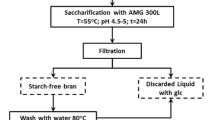Abstract
The outer layers (bran) of white wheat (Triticum aestivum L. cv. Jubilar) caryopses contain several layers of lipophilic materials. It was the objective of the present work to establish the nature, composition and amounts of the lipid polymers of wheat bran and to compare it with leaf cutin. Prior to analysis, the bran was isolated and divided into two fractions: (i) the inner bran containing the remnants of the nucellus, the seed coat and the inner layers of the pericarp, and (ii) the outer bran consisting of the peripheral layers of the pericarp. Following depolymerization, a total number of 14 long-chain monobasic, dibasic, ω-hydroxymonobasic, α-hydroxymonobasic, dihydroxymonobasic, trihydroxymonobasic and epoxyhydroxymonobasic alkanoic acids have been identified as constituents of bran lipid polymeres. The most abundant single constituent was 9,10-epoxy-18-hydroxyoctadecanoic acid. The qualitative and quantitative compositions of depolymerisates from the inner and outer bran fractions were similar except for the absence of 9,10,18-trihydroxyoctadecanoic acid and of long-chain (C22−C26 ω-hydroxyalkanoic acids in the outer bran. The composition of bran depolymerisates closely resembled the constitution of the BF3/CH3OH susceptible fraction of wheat leaf cutin. Only less than 2% of the total amount of monomers released from inner bran were indicative for the presence of suberin. The total cutin content of wheat bran amounted to 4.2 g per kg of dry caryopses. Most of it (96.6%) was contributed by the cuticles of the seed coat and the nucellus while the cuticle of the pericarp made up only 3.4%.
Similar content being viewed by others
References
Bradbury, D., Cull, I.M., MacMasters, M.M. (1956a) Structure of the mature wheat kernel I. Gross anatomy and relationships of parts. Cereal Chem.33, 329–342
Bradbury, D., MacMasters, M.M., Cull, I.M. (1956b) Structure of the mature wheat kernel II. Microscopic structure of pericarp, seed coat, and other coverings of the endosperm and germ of hard red winter wheat. Cereal Chem.33, 342–360
Collins, E.J. (1918) The structure of the integumentary system of the barley grain in relation to localized water absorption and semipermeability. Ann. Bot.32, 381–414
Espelic, K.E., Dean, B.B., Kolattukudy, P.E. (1979) Composition of lipid-derived polymers from different anatomical regions of several plant species. Plant Physiol.64, 1089–1093
Hartley, R.D. (1973) Carbohydrate esters of ferulic acid as components of cell wall ofLolium multiflorum. Phytochemistry12, 661–665
Hartley, G.S., Graham-Bryce I.J. (1980) Physical principles of pesticide behaviour. Academic Press, London New York
Hartley, R.D., Jones, E.C. (1977) Phenolic components and degradability of cell walls of grass and legume species. Phytochemistry16, 1531–1534
Hoffmann, J.A. (1987) Evaluation of bitertanol and thiabendazole seed treatment and PCNB soil treatment for control of dwarf bunt of wheat. Plant Dis.71, 839–841
Holloway, P.J. (1982) The chemical constitution of plant cutins. In: The plant cuticle, pp. 45–85. Cutler, D.F., Alvin, K.L., Price, C.E., eds. Academic Press, London New York
Holloway, P.J. (1983) Some variations in the composition of suberin from the cork layers of higher plants. Phytochemistry22, 495–502
Kolattukudy, P.E. (1981) Structure, biosynthesis, and biodegradation of cutin and suberin. Annu. Rev. Plant Physiol.32, 539–567
Krauß, L. (1933) Entwicklungsgeschichte der Früchte vonHordeum, Triticum, Bromus undPoa mit besonderer Berücksichtigung ihrer Samenschalen. Jahrb. Wiss. Bot.77, 733–808
MacMasters, M.M., Hinton, J.J.C., Bradbury, D. (1978) Microscopic structure and composition of the wheat kernel. In: Wheat: chemistry and technology, 2nd edn. pp. 51–113, Pomeranz, Y., ed. Pullman, Washington State University
Morrison, I.N. (1975) Ultrastructure of the cuticular membranes of the developing wheat grain. Can. J. Bot.53, 2077–2087
Riederer, M., Schönherr, J. (1986) Quantitative gas chromatographic analysis of methylesters of hydroxy fatty acids derived from plant cutin. J. Chromatogr.360, 151–161
Riederer, M., Schönherr, J. (1988a) Covalent binding of chemicals to plant cuticles. Quantitative determination of epoxide contents of cutins. Arch. Environ. Contam. Toxicol.17, 21–25
Riederer, M., Schönherr, J. (1988b) Development of plant cuticles, fine structure and cutin composition ofClivia miniata Reg. leaves. Planta174, 127–138
Sargent, C., Gay, J.L. (1977) Barley epidermal apoplast structure and modification by powdery mildew contact. Physiol. Plant Pathol.11, 195–205
Schmidt H.W., Schönherr, J. (1982) Development of plant cuticles: occurrence and role of non-ester bonds in the cutin ofClivia miniata Reg. leaves. Planta156, 380–384
Schönherr, J. (1982) Resistance of plant surfaces to water loss: transport properties of cutin, suberin and associated lipids. In: Encyclopedia of plant physiology, vol 12B: Physiological plant ecology, vol. 2, pp. 153–179 Lange, O.L., Nobel, P.S., Osmond, C.B., Ziegler, H., eds. Springer, Berlin Heidelberg New York
Schönherr, J., Riederer, M. (1986) Plant cuticles sorb lipophilic compounds during enzymatic isolation. Plant Cell Environ.9, 459–466
Schönherr, J., Riederer, M. (1989) Foliar penetration and accumulation of organic chemicals in plant cuticles. Rev. Environ. Contam. Toxicol.108, 1–70
Schreiber, L., Schönherr, J. (1990) Phase transitions and thermal expansion coefficients of plant cuticles: the effect of temperature on structure and function. Planta182, 186–193
Schwarz, P.B., Youngs, V.L., Shelton, D.R. (1989) Isolation and characterization of lignin from hard red spring wheat bran. Cereal Chem.66, 289–295
Smart, M.G., O'Brien, T.P. (1979) Observations on the scutellum. III. Ferulic acid as component of the cell wall in wheat and barley. Aust. J. Plant Physiol.6, 485–491
Whitmore, F.W. (1974) Phenolic acids in wheat coleoptile cell walls. Plant Physiol53, 728–731
Author information
Authors and Affiliations
Rights and permissions
About this article
Cite this article
Matzke, K., Riederer, M. The composition of the cutin of the caryopses and leaves ofTriticum aestivum L.. Planta 182, 461–466 (1990). https://doi.org/10.1007/BF02411400
Received:
Accepted:
Issue Date:
DOI: https://doi.org/10.1007/BF02411400




